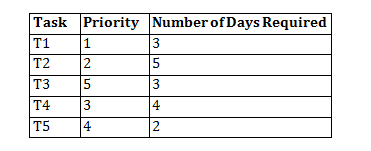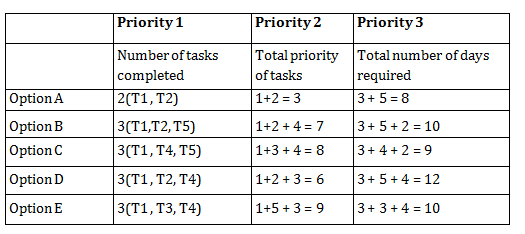Answer Questions 1 and 2 from the data given below:
Question 1. Arun has to go to the country of Ten to work on a series of tasks for which he must get a permit from the Government of Ten. Once the permit is issued, Arun can enter the country within ten years of the data of issuance of the permit. Once Arun enters Ten, he can stay for a maximum of ten days. Each of the tasks has a priority, and takes a certain number of days to complete. Arun cannot work on more than one task at a time. The following table gives the details of the priority and the number of days required for each tasks.
Arun’s first priority is to complete as many tasks as possible, and then try to complete the higher priority tasks. His last priority is to go back as soon as possible. The tasks that Arun should try to complete are:
A. T1 and T2
B. T1, T2 and T5
C. T1 , T4 and T5
D. T1 , T2 and T4
E. T1 , T3 and T4
Question 2. However, Arun’s manager has told him to do some background research on the tasks before leaving for Ten. At the same time, there is no guarantee that the Government of Ten will give the permit to Arun. Background research involves substantial costs, and therefore Arun has decided that he will not start his background research without getting the permit.
The following table gives the details of the priority, the number of days required for each task and the number of days required for background research on each task.
Arun’s first priority is to complete as many tasks as possible, and then try to complete the higher priority tasks. His last priority is to go back as soon as possible within ten days.
The tasks that Arun should try to complete are:
A. T1, T2 and T3
B. T1, T2 and T5
C. T1, T2 and T4
D. T1, T3 and T4
E. T1, T4 and T5
Answers and Explanations
Answer 1. (B)
From the table, it is clear that Arun must complete tasks T1, T2 and T5.
Answer 2. (E)
From the table, it is clear that Arun must complete tasks T1, T4 and T5.











